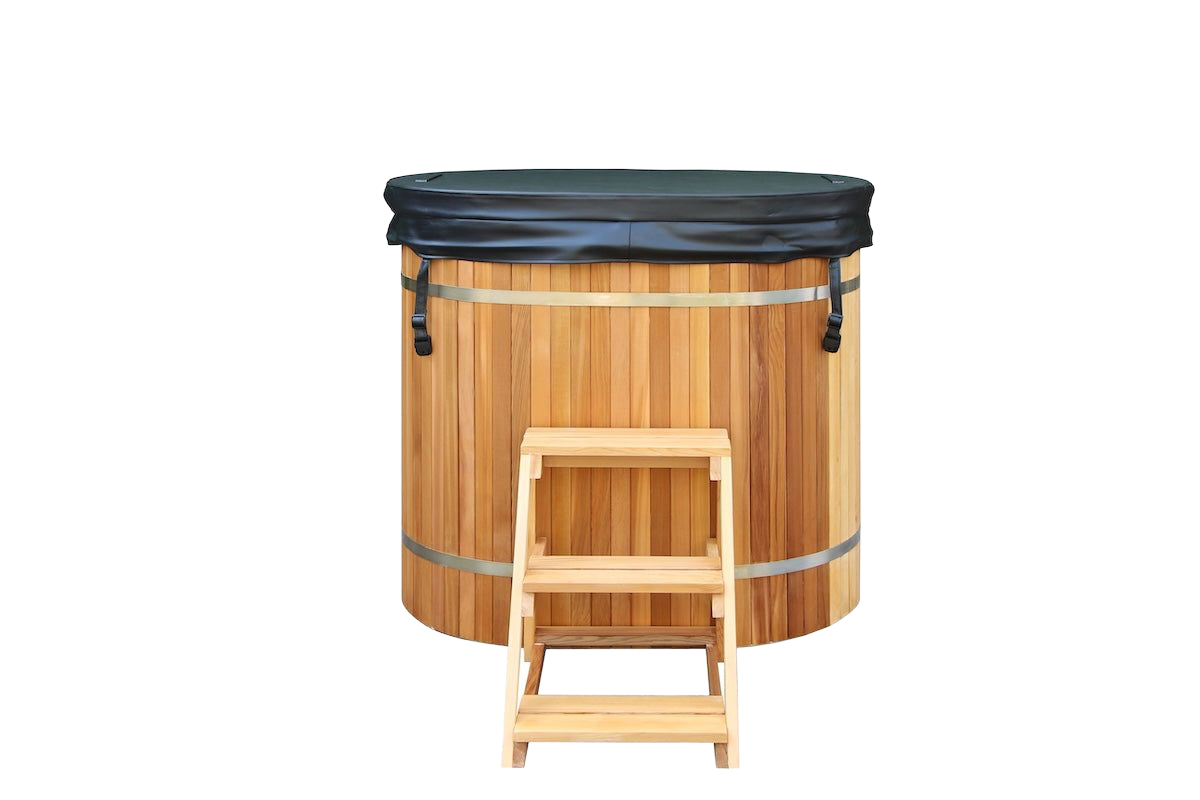Benefits of Cold Plunge
Cold plunging, also known as cold water immersion, has gained popularity for its various potential health benefits.
While the benefits are promising, it's important for individuals to approach cold plunging with caution, starting slowly and gradually increasing exposure time. Consulting with a healthcare provider is also advisable, especially for those with existing health conditions.

Neuroprotection and neuroplasticity benefits of cold water therapy
What you’re about to read is wild. Cold exposure has been shown to have protective effects against traumatic brain injuries and neurodegenerative diseases like Alzheimer’s, dementia, and Parkinson’s. Nothing excites us more than this emerging area of research, and its potential impact.
Most of us have had moments where we feel like our brain’s not quite functioning how it should – brain fog, stress, and poor sleep are common culprits. But there is also a global concern for dementia and neurodegenerative diseases, as the rates continue to rise. There are currently no cures or clear practices for prevention, but research involving cold exposure has highlighted a key protein that could be targeted to prevent and slow progression of the diseases, and approaches that could be applied more generally to sustain better brain function.
Cold Water Therapy, Neurogenesis, and RBM3
Neurogenesis is the process by which nervous system cells, known as neurons, are produced by neural stem cells. Until recently, many scientists believed that the adult central nervous system, including the brain, was incapable of regenerating. But in the 1990s, stem cells were discovered in parts of the adult brain and adult neurogenesis is now accepted to be a normal process that occurs in the healthy brain.
When you’re exposed to the cold, the body releases cold shock proteins known as RNA binding motif 3 (RBM3), which are directly linked to regeneration of synapses in the human brain. Synapses are gaps between neurons through which our neurons communicate, and are responsible for normal brain function and how we form memories. This effectively means that cold water therapy could play a role in decreasing the degeneration of our neurons, and therefore the prevention of neurodegenerative diseases, because it promotes the growth and development of nervous tissue and neurogenesis.
Norepinephrine and neurogenesis
Exposure to the cold has been proven to significantly increase norepinephrine levels, as high as 500%.Norepinephrine is a hormone and neurotransmitter which is responsible for the increased vigilance, focus, attention and mood that you get after you plunge into an ice bath or dip in the winter sea. It’s also one of the catecholamines, along with adrenaline and dopamine, and it’s produced by dopamine β-hydroxylase, which is
released either as a hormone from the adrenal medulla into the blood or as a neurotransmitter in the brain.
Studies have shown that norepinephrine enables synaptic plasticity, and directly activates self-renewing and multipotent neural precursors, including stem cells, from the hippocampus of adult mice. It’s also a neuromodulator that regulates the activity of neuronal and non-neuronal cells in multiple ways. Norepinephrine participates in the rapid modulation of cortical circuits and cellular energy metabolism, and on a slower time scale, in neuroplasticity and inflammation.

Benefits of Cold Plunging
OVERALL HEALTH
- Immune system support
- Increase blood flow
- Reduce chronic pain
- Boost your metabolism
- Better sleep
MENTAL FITNESS
- Boost in energy
- Elevate mood
- Practice discipline
- Increased resilience
RECOVERY
- Lower inflammation
- Reduce muscle soreness
- Boost performance
Enhanced Recovery
Athletes often use cold plunges to reduce muscle soreness and inflammation after intense workouts. The cold water constricts blood vessels, reducing swelling and tissue breakdown, which can speed up recovery.
Improved Circulation
Alternating between cold and warm water can stimulate blood flow. The cold causes blood vessels to constrict, and the body then works to warm itself up, increasing blood flow and circulation.
Mental Health Benefits
Cold water immersion can have a positive impact on mental health by releasing endorphins and increasing dopamine levels. This can help reduce symptoms of depression and anxiety, improving overall mood and mental clarity.
Boosted Immune System
Regular exposure to cold water can enhance the immune system. It has been suggested that it increases the production of white blood cells, which help fight off infections.
Improved Sleep
Cold plunging can aid in better sleep by lowering the body’s core temperature, which is beneficial for sleep regulation. A lower core temperature can help initiate sleepiness and improve sleep quality.
Increased Resilience
Regular cold exposure can make the body more resilient to stress. It trains the nervous system to handle stress better, leading to improved stress management and resilience in daily life.
Enhanced Metabolism
Cold water immersion can boost metabolism as the body works harder to maintain its core temperature. This increased energy expenditure can aid in weight management and fat loss..
Pain Relief
Cold plunging can act as a natural pain reliever. The numbing effect of cold water can reduce pain sensations, making it beneficial for chronic pain conditions.
How to Cold Plunge?
Cold plunges have become one of the most popular types of therapy with a wide range of health benefits. It can help improve circulation and relieve muscle soreness. Cold plunges can also help to boost your immune system and fight off infections.
For those who often have stressful days, cold plunging is also a proven method for calming down, alleviating stress, and elevating your mood. What's more, a single cold plunge can burn up to 200 calories, along with improving your skin's complexion and reducing wrinkles.
There's no doubt the health benefits are significant, so how can you enjoy them by keeping your breath under wraps?
How Long Do You Stay in the Cold Plunge?
For starters, being safe is a primary factor to be mindful of. Along with the temperature of the water, cold plunging requires vigilance regarding timing. It's important to never stay in a cold plunge too long, otherwise, you risk hypothermia.
This is why session times of 10 minutes or less are recommended, regardless of how much practice a person has. Beyond session time, though, control over breathing can ensure the best outcomes from cold plunging. Let's dive into this key aspect of ice baths next.
The Best Way to Breathe in a Cold Plunge
When you take a cold plunge, your breathing rate can increase all the way to 30 breaths per minute. That's about double the normal breathing rate for most people while they're sitting still. However, one of the keys to gaining the greatest health benefits from an ice bath is to control your breathing.
As one of the world's most extreme athletes, Wim Hof, otherwise known as "The Iceman," invented the Wim Hof Method. He believes you can accomplish incredible feats by using specific breathing techniques and tolerance to extreme temperatures to develop command over your body, breath, and mind.
1. Move To The Edge and Take a Few Deep Breaths
To kick off your cold plunge breath control, start by approaching the edge of the cold plunge and take some deep, slow, measured breaths. This will help align the body and mind to provide the sense of peace that comes from having total control over your breathing.
2. When Ready, Take a Deep Breath and Slowly Exhale
You'll want to enter the water on an exhale, which will provide room in the lungs to react to the initial shock of immersion in cold water. When plunging into frigid temperatures, the nervous system causes the lungs to automatically take a big breath in, so having empty lungs will provide plenty of space for an inrush of oxygen.
3. Keep Breathing Consistently and Slowly Enter
As you slide into the cold water, work to maintain slow, steady breathing. Your body will try to trick your brain into short, fast, shallow breaths, so it's important to focus your mind on slowing everything down. Taking deep, slow breaths will help you get the right amount of oxygen into your blood, enhancing the benefits of your ice bath.
4. While in the Water, Focus on Even Breathing
Maintaining even, measured breaths for the entire session is the goal of taking an ice bath. When first starting out, this can be easier said than done, but practice makes perfect.
Rather than letting the mind shift to the discomfort of cold immersion, instead, direct your mental energy toward staying in control. With more experience, this practice can deliver a sense of peace and well-being, much the way meditation can.
5. If You Feel Anxious, Slow Your Breaths Down
At first, it can be a significant struggle to stay calm when getting into an ice bath. One of the most common bodily responses is feeling panicked or anxious, which produces rapid breathing rates.
If you feel yourself drifting into this mental territory, redirect your attention to your breathing. The simple act of taking slow breaths is immensely helpful for remaining calm in any situation, especially when it comes to cold exposure.



